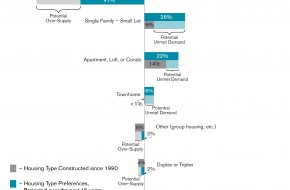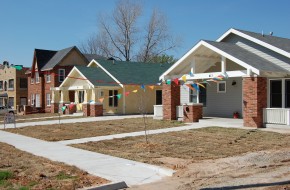Housing Market Study
The housing market is a vital component in the growth and development of a city. With this in mind, the City completed a Housing Market Preference and Demand Study in 2013 to help determine whether and to what extent the market for housing might change over the next several years. The study, which included a survey of area households, found that both urban and suburban housing demand is strongly influenced by a few key neighborhood characteristics. Additionally, there is demand pressure towards nearby suburban communities which may cause continued out-migration of households and resources if urban neighborhood improvements are deemed inadequate.
Important Neighborhood Characteristics
There are a few characteristics, primarily associated with location or neighborhood as opposed to the residence itself, that households in Oklahoma City find particularly important when deciding where to look for a place to live:
- High-intensity mixed-use, walkable urban neighborhoods: This characteristic is all about options. Many more households are showing interest in places where they have a wide variety of things to do and ways to get around.
- Close proximity to schools, shops, jobs, and entertainment options: Not everyone is attracted to high-intensity urban places; however being close to things they need or want on a regular basis is important to a vast majority of Oklahoma City households.
- Wide variety of housing types: People recognize that their housing needs change over time, and they want access to different types of housing that meets these needs. Ideally, these housing options would be available in areas of the city they are already familiar with, be it their current neighborhood or a place they visit frequently. Households also recognize that different housing types allow their families to stay close. Grandparents, parents, children, and grandchildren can live in the same neighborhood but have a home that closely meets their needs.
- High quality public schools: A product that is always in high demand, great schools can serve as an anchor for vibrant neighborhoods.
- Low-density suburban neighborhoods: Houses situated on large lots near the edge of the city are still in high demand. One of the unique assets of Oklahoma City is its capacity to provide both high-intensity urban and low density suburban areas.
Key Challenges and Findings
The above characteristics, which impact demand, result in several key findings about household demand in Oklahoma City:
- Oklahoma City is projected to need more than 70,000 new housing units by 2030.
- Nearly 50% of households plan to move either outside the region (15%) or within the region (32%) in the next five years.
- Oklahoma City has a relatively homogeneous housing stock, especially when considering homes built in the past 20-30 years.
- Sense of safety and security is the single most important neighborhood characteristic.
- Characteristics of neighborhoods are five times more important than characteristics of the houses themselves.
- Perceived school quality is an important locational consideration for households, whether they have schooled-aged children or not.
- Specific project and program investments will cause a positive (or negative) impact on demand for different areas throughout the city.
- Oklahoma City households understand the value of key neighborhood amenities and expressed a willingness to pay for them.
Recommendations
The City can take action to increase demand for the central areas of the city by building on existing assets. The following recommendations are tailored to the preferences expressed by Oklahoma City households and will have the greatest impact on the economic, social, and fiscal profile of the city, especially for the emerging generation of home buyers. (Those born between 1982-1999 account for 30% of the OKC metro population.)
- Make strategic, prioritized investments, especially those which increase transportation choices, in areas that have the greatest potential to attract new households.
- Create specific plans that highlight opportunities for increased connectivity, walkability, and bikeability for those areas shown by the Housing Study to be responsive to change.
- Complete a community safety study to gain more understanding about what the City can do to help places feel safe and secure.
- Update design requirements to incorporate components related to safety.
- Improve partnerships with local school districts to ensure the City is doing its part to bring high quality education into neighborhoods.
- Update regulations to help neighborhoods establish, reinforce, or enhance “sense of place” – generally understood to mean a place that feels comfortable and distinct from other places.
- Periodically study the housing preferences and demand of Oklahoma City households and revise plans, priority projects, and areas as necessary.
























